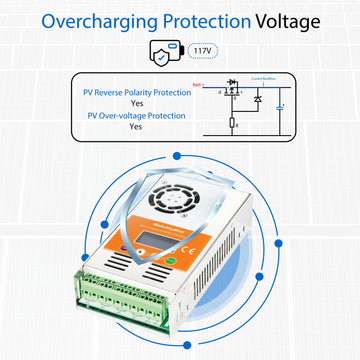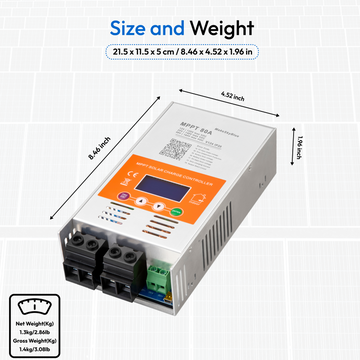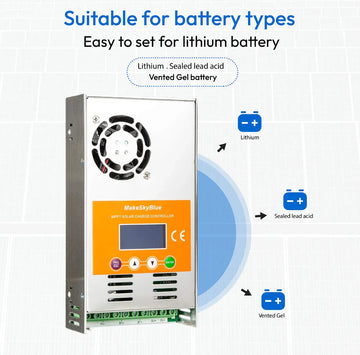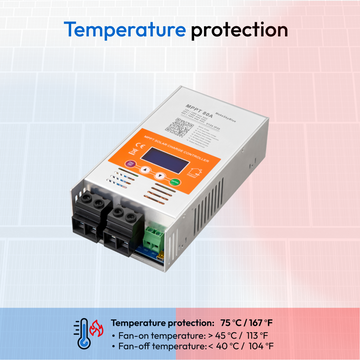There is need for ideal voltage regulation between panels and batteries in solar energy systems. Without proper control, batteries are subjected to early failure and safety hazard. The charge controller for solar installations serves as the critical component managing power flow and protecting expensive battery banks.
The global solar charge controller market reached USD 2.46 billion in 2025 and shows strong growth projections toward USD 4.61 billion by 2033.
How a Charge Controller for Solar Protects Your Investment?
Battery protection stands as the primary function of these devices.The key role of such devices is battery protection. For the whole day, solar panels give different voltages depending on the intensity of the sunlight. Direct connection leads to voltage spikes which destroys battery cells and shortens lifespan considerably.
The device is able to measure battery voltage and regulate charging current. The controller automatically slows down the flow of power when the batteries are full. Battery chemistry and charging needs are influenced by changes in temperature. Advanced controllers include compensation features that adjust voltage based on ambient conditions
Different Types of Charge Controllers for Solar Applications
PWM Technology Basics
Pulse Width Modulation controllers use switching technology to regulate power flow. These devices turn charging current on and off rapidly to maintain proper voltage levels. PWM units cost less than advanced alternatives and suit smaller installations under 500 watts.
MPPT Advanced Control
Maximum Power Point Tracking represents the latest controller technology. These sophisticated devices actively track optimal panel operating points and extract maximum available power. MPPT controllers demonstrate efficiency gains up to 30% compared to PWM technology.
The conversion process transforms excess voltage into additional charging current. This increases daily energy harvest substantially, especially during morning and evening hours. Commercial applications dominated the market in 2024 as businesses seek to reduce electricity costs.
MakeSkyBlue offers MPPT controllers ranging from 30A to 120A capacity. Their V123 and V125 series support multiple battery types including lithium and lead-acid systems.
Critical Features to Consider in Modern Controllers
Voltage and Current Ratings
System voltage determines controller compatibility. Common options include 12V, 24V, 36V, and 48V configurations. Calculate total panel current by adding short-circuit ratings of all panels. Multiply by 1.25 for safety margin and select controllers rated above this value.
Battery Type Compatibility
Different battery chemistries require specific charging algorithms. Lead-acid batteries need three-stage charging while lithium batteries demand precise voltage control. Our controllers include specialized lithium modes with BMS activation and PV start features.
Protection Mechanisms
Quality controllers incorporate multiple safety features:
-
Overcharge protection stops current flow when batteries reach full capacity
-
Deep discharge prevention disconnects loads before batteries drain completely
-
Short circuit protection safeguards against wiring faults
-
Reverse polarity prevention protects from incorrect connections
-
Temperature compensation adjusts charging for ambient conditions
Monitoring Capabilities
Remote monitoring transforms system management. WiFi connectivity enables real-time performance tracking from smartphones. MakeSkyBlue integrates cloud monitoring in their latest models with instant alerts about system issues.
Selecting the Right Charge Controller for Solar System Size
Small systems under 500 watts typically use PWM controllers for cost efficiency. Medium installations between 500-2000 watts benefit from entry-level MPPT technology. Large residential and commercial systems require advanced MPPT controllers with high current ratings.
Panel configuration affects controller selection significantly. Controllers must handle the maximum voltage and current your array produces. They handle up to 120A continuous current for large installations.
Technical Comparison Between Controller Technologies
|
Specification |
PWM Controllers |
MPPT Controllers |
|
Energy Conversion Efficiency |
75-80% typical |
92-98% typical |
|
Panel Voltage Flexibility |
Limited matching |
Wide range support |
|
Cold Weather Performance |
Standard |
Enhanced harvest |
|
System Complexity |
Simple operation |
Advanced features |
|
Initial Investment |
Lower cost |
Higher price point |
|
Payback Period |
Immediate |
2-4 years |
|
Best Applications |
Small systems |
Medium to large |
|
Voltage Conversion |
None |
Active conversion |
Installation Requirements and Best Practices
The location choice has an effect on the performance and life of controllers. Install in well ventilated places that are not in direct contact with sun and moisture. Remember to position controllers near batteries to reduce voltage drop. Keep cable runs short and use appropriately sized wire for current levels.
Vertical mounting permits adequate heat loss. Make sure that there is enough clearance space around units to allow for air to circulate. Place the system in a proper manner as per electrical codes. Install breakers or fuses around batteries to provide more protection.
Common Problems Prevented by Quality Controllers
Overcharging destroys battery plates through excessive gassing and heat generation. Controllers prevent these scenarios by limiting voltage precisely. Deep discharge causes sulfation in lead-acid batteries and capacity loss in lithium types. Low-voltage disconnect features preserve battery health.
Reverse current flow wastes stored energy during nighttime hours. Built-in blocking prevents batteries from discharging back through panels. Temperature extremes affect battery charging requirements significantly. Controllers with temperature sensors adjust voltage automatically.
Performance Factors Affecting Energy Harvest
Panel orientation and tilt angle impact daily energy production. South-facing installations in the northern hemisphere capture maximum sunlight. Shading reduces panel output dramatically. Keep arrays clear of shade throughout the day.
Cable sizing affects system efficiency through voltage drop. Longer cable runs require larger wire gauge. Battery condition influences charging efficiency. Regular testing identifies failing batteries before they affect system operation.
Maintenance and Monitoring Guidelines
Inspect connections quarterly for corrosion and tightness. Loose terminals create resistance and reduce efficiency. Check battery voltage regularly in lead-acid systems. Review monitoring data monthly for performance trends.
Clean panels semi-annually to remove accumulated dirt and debris. Simple washing restores output to optimal levels.
System Design Considerations for Optimal Performance
Match array voltage to controller input specifications carefully. Exceeding maximum voltage damages electronics instantly. Calculate daily energy requirements accurately before sizing components. Select battery capacity appropriate for daily usage patterns.
Consider seasonal variations in solar availability during planning. Winter production drops significantly in higher latitudes. Larger arrays compensate for reduced winter sunlight.
System Voltage Configuration Comparison
|
System Voltage |
Typical Applications |
Current Levels |
Cable Sizing |
Controller Options |
|
12V |
Small RVs, boats |
High current |
Large gauge wire |
Limited capacity |
|
24V |
Medium homes |
Moderate current |
Medium gauge |
Good selection |
|
36V |
Large residential |
Lower current |
Smaller gauge |
Growing options |
|
48V |
Commercial systems |
Lowest current |
Efficient sizing |
Wide availability |
|
96V |
Industrial applications |
Very low current |
Minimal losses |
Powerful option |
Advanced Features in Premium Controllers
Programmable charging parameters enable customization for specific battery types. Users adjust voltage setpoints to match manufacturer recommendations. Load control outputs provide automatic power management for connected devices.
Data logging captures system performance for analysis. Historical records reveal patterns and identify problems early. Communication interfaces connect controllers to monitoring systems for commercial installations.
Real-World Applications and Use Cases
Residential installations benefit from reliable battery charging and protection. Agricultural operations use solar systems for irrigation pumping. Controllers manage power flow to critical equipment reliably.
Telecommunications sites depend on solar backup systems for continuous operation. Recreational vehicles require compact efficient charging systems. Controllers maximize limited roof space while protecting house batteries.
Conclusion
Charge controllers protect solar investments while maximizing energy harvest. Technology selection between PWM and MPPT depends on system size and budget considerations. Quality controllers from MakeSkyBlue deliver reliable performance across residential and commercial applications. Proper installation and regular monitoring ensure optimal system operation for years.
FAQs
What happens to solar systems without a charge controller for solar protection?
Batteries suffer immediate damage from unregulated charging voltage. Overcharging causes permanent capacity loss and creates safety hazards. Most batteries fail within weeks without proper regulation.
How does system size affect charge controller for solar selection?
Smaller systems under 500 watts work well with PWM technology. Larger installations benefit from MPPT efficiency gains despite higher initial costs. Calculate total panel current and add 25% safety margin.
Can one charge controller for solar manage different battery types?
Modern controllers support multiple battery chemistries through programmable settings. Lead-acid and lithium batteries require different voltage parameters.
What determines the lifespan of a charge controller for solar systems?
Quality construction and proper ventilation extend controller life beyond 10 years. Operating temperature significantly impacts electronic component longevity. MakeSkyBlue products feature robust thermal management for extended service.
Why do MPPT charge controllers for solar cost more than PWM?
Advanced electronics and sophisticated algorithms increase manufacturing complexity. MPPT controllers include voltage conversion circuitry and tracking processors. The additional energy harvest typically recovers the cost difference within three years.




